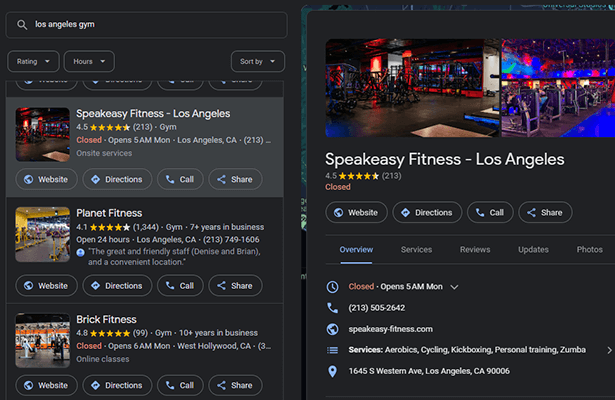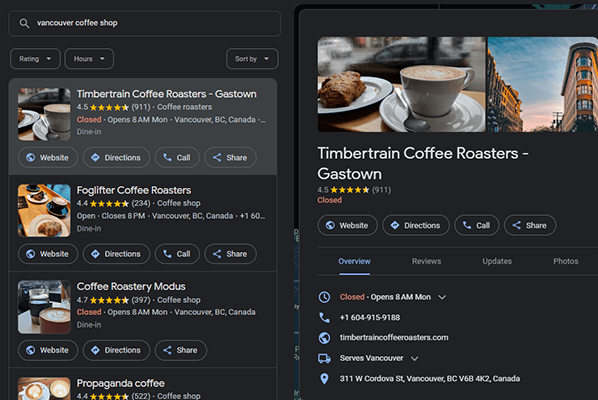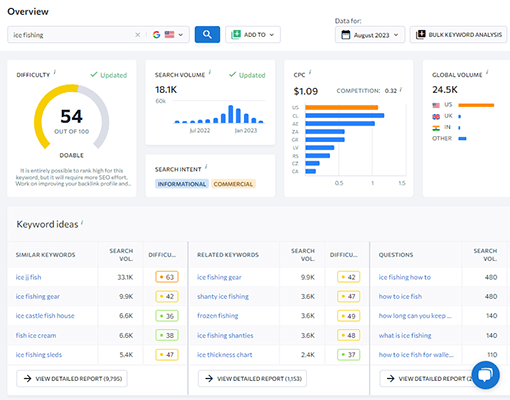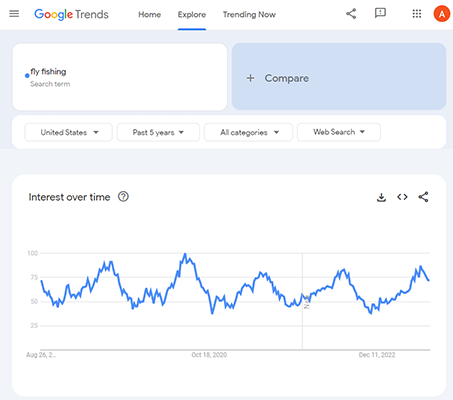How To Find A Niche For Your Business

Are you starting a business and need to learn how to find your niche?
In this step, we cover a step-by-step process on how to find your niche, which includes identifying a target market and a problem you can solve.
Let’s get into it.
How to find your business niche
Finding a niche for your business is one of the most important first steps you can take when starting a business.
It’ll set you up for success early on, and it’ll help you find your target niche market much quicker.
We’re going to cover how to find your niche step by step because of this.
Let’s start at the top.
1. Understand what a niche is and why finding one is important for starting a profitable business
A niche is the specific topic, market or problem your business targets.
Here’s an example: Subway and McDonald’s are both fast food restaurants, but they target different niches. Subway’s niche is the sandwich industry while McDonald’s is a burger chain.
By focusing on a single fast food dish rather than all food in general, both restaurants were able to thrive.
This is what you should strive for when working on finding your niche. It’s the key to launching a profitable business.
The benefits of finding your niche
From that simple example, we can identify a few key benefits of finding a niche for your business.
1. It helps you define your unique selling point.
Defining your niche also helps you define your unique selling point, which in turn, will help you come up with the perfect business idea.
A unique selling point is something you have that your competitors don’t.
To put it simply, it’s why your target customers will most likely choose your business over a similar business.
2. It helps you understand your target market better.
Subway and McDonald’s technically have the same target market: consumers who want a simple, familiar meal that’s cheap and quickly made.
However, Subway really made a name for itself by targeting a specific market within that pool of consumers who want cheap food quickly, and that’s consumers who want a healthier option when it comes to fast food.
In short, your target market is the specific group of consumers you promote your products to within the broader topic your niche belongs to.
By focusing on that smaller market, you’re more likely to earn a profit than you would have had you decided to focus on the broader aspect of your niche.
3. It helps you choose an area of focus.
It’s really easy to burn yourself out during the beginning phases of starting a business.
Unless you received a pretty sizable loan or funding, you don’t yet have enough funds to hire employees to help you run everything.
Choosing a niche gives you a specific area of focus to start with as you grow your business.
4. It’ll help you earn revenue early on.
This is what all of the benefits of finding a niche leads up to.
By finding your target market early on, you also set yourself up for earning revenue early on.
There’s something missing in the broader topic your niche belongs to, a problem other businesses aren’t tackling well, if at all.
That’s what we’re going to find throughout the rest of this post.
2. Understand what makes the perfect niche
Okay, so when it comes down to it, a niche is a target market within a broader topic or a problem you can tackle within a broader topic.
But how do you choose what that broader topic is? You learn what makes up the perfect niche.
The perfect niche for you is a topic that’s…
- something you’re passionate about.
- something you’re knowledgeable about.
- something that has the potential to be profitable.

The perfect niche has all three. Let’s get into how to find it.
3. Make a list of your interests
Open your preferred method for taking notes, and make a simple list of everything you’re interested in.
Don’t worry about concrete business ideas at this stage. This is just a brainstorming session.
Come up with as many interests as you can.
They can be hobbies, entertainment franchises you’re into, music you’re into, food, cultures, clothing, etc.
Try to look around your home and maybe even your social media history for a few additional ideas.
4. Make a list of what you know
You may think this part of the tutorial will produce the same list as Step 3, but you may surprise yourself.
You probably aren’t defining everything you know as an “interest.”
For example, if you’re a parent, you probably know quite a bit about child care.
If you’re a homeowner, you probably know your way around a few household tools.
Heck, even your career can be something you’re knowledgeable about while also not being something you consider an interest.
With that said, add topics you’re familiar with to your list before you continue on to Step 5.
5. Turn your ideas into niches
Let’s say your list looks a little something like this:
- Interests
- Fishing
- Skateboarding
- Coffee and tea
- Widdling
- What I Know
- Fatherhood
- Computer repair
- Home repair
These topics are far too broad to base an entire business around, so we need to transform them into niches.
But how do we do that?
Start by breaking each niche down into smaller topics. Just make sure you’re still interested in those topics.
For example, we could break “fishing” down into “ice fishing,” “fly fishing,” “river fishing,” “Great Lakes fishing,” etc.
You should also consider your unique selling point here.
For example, if you live near Seattle, focus on “Seattle fishing.”
Spend a little time breaking each item on your list into smaller topics that could potentially be your business niche.
Niche market examples
Subway and McDonald’s, while being two great examples of similar restaurants that target separate niches, are big, multi-billionaire corporations that are hard to draw inspiration from if you’re just starting out.
Let’s go over a couple of examples from smaller niche businesses instead.
Speakeasy Fitness – Los Angeles, California, USA
LA has a lot of gyms.
Even so, this gym has been able to acquire over 200 reviews and an average 4.5-star rating in just four months of being open.

But what sets them apart from all of the other gyms in the city?
The gym has plenty of amenities, such as a pool, jacuzzi, sauna, basketball courts and a juice bar, but these aren’t why gym rats have flocked to this gym in droves within four months of it being open.
It’s the gym’s ability to provide what you don’t find a lot of in a big city that sets it apart: lots of space and plenty of duplicates of the same machines so you never have to wait around for an opening.
That’s something not a lot of consumers can say about businesses in LA.
Plus, patrons love the “vibes” the gym gives off while they’re there as well as the fact that they always play electronic dance music (EDM) to get you fired up.
Timbertrain Coffee Roasters – Vancouver, British Columbia, Canada
The Pacific Northwest is well known for its vast number of coffee shops. How is any shop supposed to stand out?
Timbertrain Coffee Roasters certainly has no problem standing out in the Vancouver area.

Not only does the shop have a train theme, they also serve artisanal coffee and latte art made from hand-roasted beans.
Some brews are even handcrafted, so you won’t find them anywhere else.
Plus, the shop sells packages of its blends so patrons can brew a few cups at home whenever they want.
The Cat Ball – US-Based Online Store
Let’s cover an online business for our last example.
The Cat Ball can technically be classified as an online pet store, but it doesn’t simply target all pets or even one type of pet.
Instead, they target a specific need for a specific pet: cute beds crafted specifically for our feline friends.

The beds come in a variety of different formats and several different styles.
They’re quite unique, too, and there’s something for every type of decor out there.
This all has helped The Cat Ball grow in the pet industry, well enough to get recognized by a celebrity like Cindy Crawford and by media outlets like BuzzFeed, The Oprah Magazine and HGTV.
6. Determine each niche’s search potential
Now, it’s time for the hard part: putting data behind each niche idea.
Let’s start with determining each niche’s potential in search engines, such as Google.
You can use any keyword research tool for this part.
We’re quite fond of SE Ranking and Mangools. Both are quite affordable and have free trials.
Feel free to create a spreadsheet for this step, but you can just as easily use your notes.
Figure out the best way to turn each niche idea into searchable keywords, then input each one into your chosen keyword research tool.
Not only will this give you an idea of how each niche performs as a keyword, it may also give you additional niche ideas.
For example, running an analysis of the keyword “ice fishing” in SE Ranking returns additional keywords like “ice fishing gear,” “ice fishing shanties” and “ice fishing sleds,” all of which are fantastic business ideas.

For each niche idea you input as a keyword into your chosen keyword tool, record the following metrics:
- Search Volume – How many times the keyword is searched for on Google every month on average. Make sure you record the metric for your target region.
- Keyword/SEO Difficulty – How difficult it would be to rank for this keyword. Lower is better.
- CPC – Cost per click, which is how much advertisers pay per click when they target this keyword with search ads.
You’re looking for a niche that has a high search volume but a low keyword difficulty.
This means the topic is high in demand but low in competition.
You can also use a free tool like Google Trends to determine consumer interest in each niche over time.

Go through each keyword and record these metrics for each, including additional keywords you find like “ice fishing gear.”
Then, remove each niche whose search volume seems to be too low or whose keyword difficulty is 70 or higher.
7. Determine how popular each niche is on social media
Your list should be a little smaller by now. Let’s make it even smaller by researching each one on social media.
Focus on the big platforms: TikTok, Instagram, YouTube, Facebook and X (Twitter).
Enter each niche as a keyword into each platform, and pay attention to the following data:
- Videos related to each niche, including the average number of views and likes each one has.
- Content creators related to each niche, including how many followers each creator has.
You don’t necessarily need to write down metrics for this step.
A few notes will suffice, such as “most videos don’t have many views” or “a lot of creators with 100,000 followers or more.”
If you’re not that interested in a specific niche, and it seems to have too much competition on social media, remove it from the list.
It’s not impossible to gain a following where competitors are already highly successful, but your heart really needs to be in it.
8. Determine how profitable each niche is
This one requires searching in a few different places to determine.
Go to these places to determine how your future competitors are generating revenue from each niche:
- Amazon, enter your niche into the search bar and see what products come up
- Department stores in your region, such as Walmart, enter each niche into the search bar
- Googling “[niche] stores”
- Googling “[niche] services”
This will give you a good indicator of how viable each potential niche is in terms of generating a profit.
You have a few different choices you can make with this step:
- Remove niches that seem too competitive.
- Highlight niches that seem to have a few areas where needs are not being met.
You don’t necessarily need to remove niches that don’t have much competition. It could simply be that no one is providing a decent product in that space.
But pay attention to products that don’t get much attention, such as if they have a low number of reviews, especially if they seem to be of quality.
This is an indicator of a niche that doesn’t have enough consumer interest.
9. Choose a niche
This part is all up to you.
You have your data.
You know what your passions are.
You know what topics you’re most knowledgeable in.
Now, it’s time to go through your list of ideas and choose a niche.
Again, you want a niche that you’re interested in, are at least a little bit knowledgeable of and seems to have potential to earn revenue.
10. Find your target market within your niche
Okay, there’s one last step to finding your perfect niche: finding your perfect target market.
To find niche markets, you need to:
- Research your competitors.
- Identify a problem you can solve.
- Consider your unique selling point.
Let’s go over each step.
Researching your competitors
There’s likely already businesses in your niche tackling a lot of the problems you’re about to tackle.
While that may seem intimidating, it’s actually a good thing. It gives you plenty of market research to go off of.
Pay attention to the products and services your competitors offer related to your niche. It’ll give you ideas on products and services of your own to offer.
Most importantly, it’ll let you see where your competitors fall short.
Read reviews for products your competitors create. Go through their reviews on platforms like Google, Facebook and Yelp.
Enter their business and product names into the search fields of various social media platforms to see if customers have any complaints.
There’s likely something your competitors are missing. You just need to do a little research to determine what that something is.
Identifying a problem you can solve
The research you do on your competitors may clue you into the golden egg of finding your niche: identifying a problem you can solve that’s not being solved by your competitors.
Whatever product or service you come out with to solve that problem will seem very intriguing and fresh to consumers in your target market.
You could even target a problem that’s already being solved, only in a new and more efficient way.
Think of services like Uber and Airbnb. Both found new ways to tackle their respective niches, the transportation and travel industries.
Beyond making note of ways your competitors fall short in your niche, for help on identifying problems your target market is having, use a few different methods.
This includes looking through forums and subreddits related to your niche.
Do a deep dive on them to see what consumers in your target market struggle with most, and come up with a few different ways to solve those struggles.
You can also enter your niche as a keyword into Google. Google showcases frequently asked questions consumers have for each niche.
For example, when you Google the term “ice fishing,” the following questions come up:
- How do you ice fish in [location?]
- What are the rules for ice fishing in [location]?
- What is the best season for ice fishing?
These are basic questions consumers want answered.
Consider teaching them by becoming an ice fishing guide, writing a book on ice fishing in your region, starting a TikTok series on ice fishing, creating a YouTube channel on ice fishing, coming up with a beginner’s ice fishing starting kit of some kind, etc.
You can also chat one-on-one with members of your target audience. Learn everything about how they approach your niche, and talk in depth about any struggles they experience.
Lastly, view content related to your chosen niche.
The comment section will likely have a few complaints you can add to your research.
A much longer approach to this method would be to start a YouTube channel or TikTok account of your own. Your marketing efforts will uncover struggles your audience is having.
Your unique selling proposition
Lastly, consider your unique selling point.
For example, if every fishing guide in the ice fishing niche seems to be men and you’re a woman, use that angle in your marketing.
It can be as heavy hitting or as subtle as you want it to be.
The bottom line is if there’s something about you that’s obviously different from your competitors, consumers will likely notice it, too.
Related Reading: 7 Value Proposition Examples (And How To Create Your Own)
Final thoughts
That’s all we have on how to find a niche for your business.
We know this is a bit of an involved process, but if you want an easier time of getting your business off the ground early on, you’re going to want to take the time to find a target market that doesn’t have many products or services consumers can rely on.
Remember, the perfect business niche is a topic you care a lot about, one you have a lot of knowledge on and one that consumers care about as well.
Related Reading: 36 Best Blog Niches That Actually Make Money.
